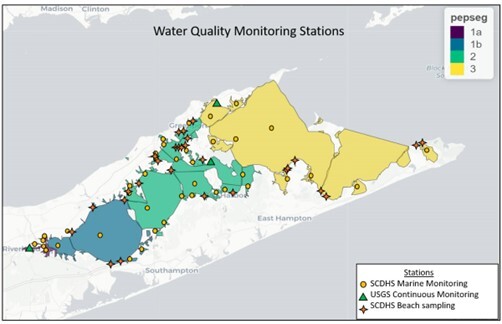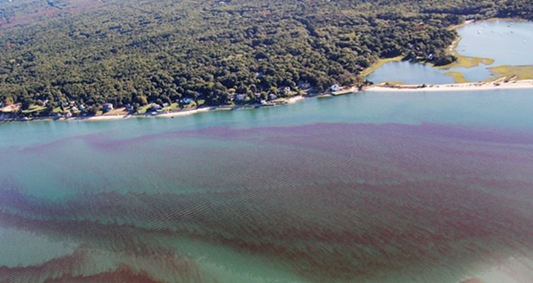Long Island Nitrogen Action Plan (LINAP)- Newsletter
The New York State Department of Environmental Conservation sent this bulletin on 09/19/2023 09:00 AM EDT |
| DEC Delivers - Information to keep you connected and informed from the NYS Department of Environmental Conservation |
Long Island Nitrogen Action Plan (LINAP)- Newsletter
|
|
Peconic Estuary Nitrogen Load Reduction Cost Assessment Tool The Peconic Estuary Nitrogen Load Reduction Cost Assessment tool was developed to aid the Peconic Estuary Partnership and its stakeholders in achieving nitrogen load reductions to groundwater within the watershed. The tool determines the cost per pound of nitrogen reduction for a multitude of best management practices (BMPs) available in the Peconic Estuary Watershed. The compilation of suitable BMPs along with the data concerning nitrogen removal quantities and associated expenses, was developed from information received from Suffolk County, the Center for Clean Water Technology, regional entities like the Cape Cod and Chesapeake Bay Commissions, as well as comprehensive literature reviews and feedback from the Peconic Estuary Partnership. The BMPs take into account the geographical, environmental, and climate-based factors in eastern Suffolk County and have been carefully chosen to mitigate nitrogen from primary sources within the Peconic Estuary watershed. They are grouped by the following categories: septic waste, surface runoff, potential agriculture, water reuse, septic waste experimental, groundwater, turf grass fertilizer and bioextraction. Click here to access the tool and to find out more information on the methodology and list of BMP technologies available for each parcel in the watershed. Carbon Emulsion Permeable Reactive Barrier at Tanbark Creek In 2022, the Cornell Cooperative Extension (CCE) of Suffolk County installed a carbon emulsion permeable reactive barrier (PRB) in Tanbark Creek to treat groundwater nitrate entering Three Mile Harbor. A PRB is a wall created below ground to treat contaminated groundwater. The wall is “permeable,” which means that groundwater can flow through it. The “reactive” material, carbon, that make up the wall either traps harmful contaminants or treats them to make them less harmful. The treated groundwater flows out the other side of the wall. This year CCE has been monitoring the effectiveness of this PRB since its installation. This project will add to a repository of PRB performance data and inform several long-term goals for PRB implementation in the estuary. The goals include but are not limited to: connecting inland PRB performance to offshore pore water and surface water quality, maximizing the longevity of PRBs, and maximizing nitrate reduction by potentially including other environmentally approved reactive materials. For more information on this project contact Sara Cernadas-Martin, PhD at sara.cernadas@stonybrook.edu. Water Quality Monitoring Report The Suffolk County Department of Health Services (SCDHS) has carried out water quality sampling in the Peconic Estuary since 1977. In 2012, PEP partnered with the USGS to install two Continuous Water Quality Monitoring stations in the Peconic Estuary, one in Orient Harbor and another at the mouth of the Peconic River. Last year a third USGS Station was installed on Shelter Island at the South Ferry Dock. Together, the SCDHS and USGS monitoring systems provides valuable water quality information which is documented each year in PEP’s Annual Water Quality Report. The Water Quality Report enables PEP to track progress on meeting the goals set forth in the Comprehensive Conservation and Management Plan (CCMP) for Resilient Communities Prepared for Climate Change, Clean Waters for Ecosystem Health and Safe Recreation, and Healthy Ecosystem with Abundant, Diverse Wildlife over the next decade. The report tracks five water quality parameters - water clarity, dissolved oxygen, total nitrogen, levels of chlorophyll-a, and pathogen levels at beaches. To facilitate reporting and management, the estuary has been divided into three sections: western (river influence and estuarine influence), central, and eastern. In 2022, the western section continued to fall short of meeting target criteria across all parameters when compared to the eastern section. Addressing these challenges in the western area is a top priority for PEP in developing and implementing management strategies aimed at enhancing the overall health of the estuary. Click here to view all water quality monitoring data from 1990-2022.
PEP water quality monitoring sampling stations. The data collected at these stations is used for the PEP surface water quality monitoring. Photo Credit: PEP. Septic Improvement Program Support The Peconic Estuary Program (PEP), in collaboration with the Suffolk County Department of Health Services, has been actively engaged in outreach initiatives aimed at educating the residents of the East End region. A significant highlight of this outreach has been the County's Septic Improvement Program, a grant and loan program for homeowners to replace their outdated cesspools and septic systems with nitrogen reducing Innovative/Alternative Onsite Wastewater Treatment Systems (I/A OWTS). This program has been successful. In 2022, 134 residential I/A OWTS installations were completed, alongside two for commercial use in the Peconic Estuary watershed. These systems collectively contributed to the annual removal of approximately 2,900 pounds of nitrogen from the environment! In 2023, PEP has continued its commitment. They allocated $95,000 to Suffolk County for the sole purpose of providing support to low- and median-income families to help them maintain their I/A OWTS systems. By offering this support, PEP aims to further incentivize the adoption and proper upkeep of I/A OWTS as a crucial tool for reducing nitrogen in the watershed. Harmful Algal Bloom Study in Priority Embayments This year marks the second year of PEP funding for the Stony Brook University’s School of Marine and Atmospheric Sciences Gobler Laboratory research on harmful algal blooms (HABs) in designated priority embayments. The study is analyzing three HABs (rust tide, mahogany tide and toxic blue green algae) that recur annually across the Estuary. The goals are to assess how the changes in nutrients over time affect HABs within bloom prone regions, the ability of nitrogen and phosphorus to intensify HABs, and the levels of nutrient load reduction needed to lessen the intensity of these HABs. This cutting-edge research will identify specific nitrogen reduction targets needed to prevent blooms of each of the three species of HABs being studied. HABs continue to be a threat to the economic and recreational value of the watershed. The study is expected to be complete next year.
Rust tide in the Peconic Bay. Photo credit: PEP Grant Opportunity- North American Wetlands Conservation Act (NAWCA) Grants: Small Grants Program The Small Grants Program, run through the U.S. Fish and Wildlife Service (USFWS), is a competitive matching grants program that supports public-private partnerships carrying out projects in the United States that further the goals of the North American Wetlands Conservation Act. These projects must involve long-term protection, restoration, and/or enhancement of wetlands and associated uplands habitats for the benefit of all wetlands-associated migratory birds. Wetlands can play a strong role in improving water quality by trapping sediment from runoff and remove nutrients. Additionally coastal wetlands can assist with adaptation to climate change by stabilizing shorelines and provide water filtration and habitat for fish and other wildlife. Deadline to apply: October 12, 2023. For more information on how to apply, eligibility, and proposal outlines, visit the NAWCA Small Grants Program webpage here. To sign up for the LINAP newsletter, visit our webpage or click here. |


